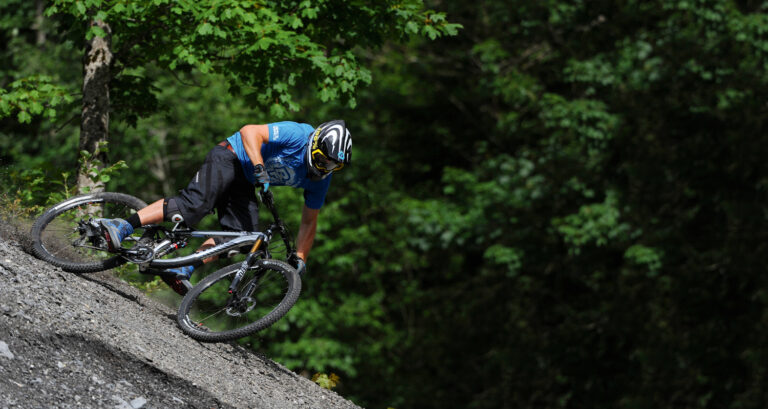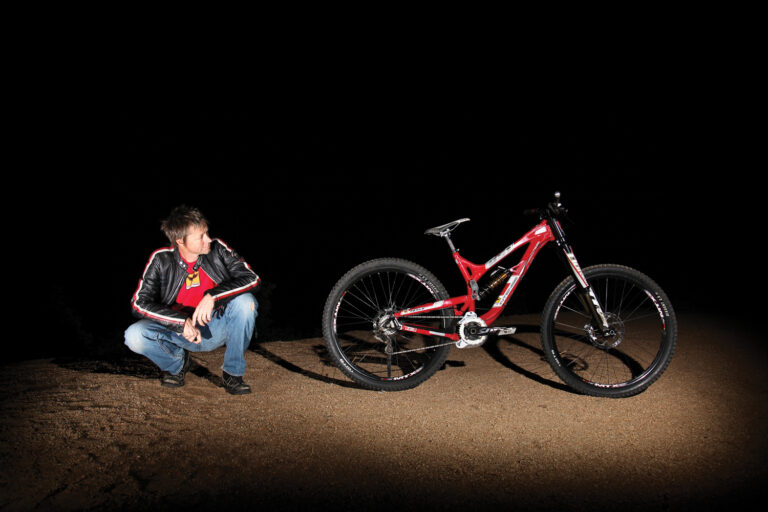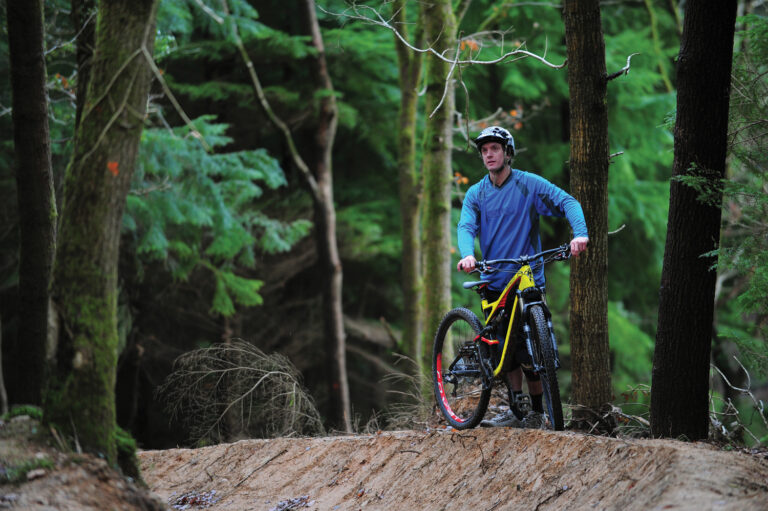 SANTA CRUZ TALLBOY – 120/100mm
SANTA CRUZ TALLBOY – 120/100mm
The Tallboy was my first memorable full suspension 29 experience. I liked it, Billy the web editor liked it, Josh Bryceland was even hooked. I heard stories of well–known bike tester Guy Kesteven being banned from riding one simply due to the beating he dished out to everyone.
On man–made Gisburn forest trails the Tallboy made light of the slightly washed out ground, but I really found the cornering something of an oddity – too far forward, too far back – I was hardly bossing the bike. Yet it transported me and left me with many questions unanswered. Was I on the right size? What would happen in the tight?
To be blunt, the Tallboy is too short up front. It loads a rider’s body weight over the front tyre resulting in poor steering and less than reassuring stability at speed, especially on descents. I also wonder how the bike would feel with an even shorter fork than the one fitted. This is a shame because the acceleration of the Santa Cruz is like many in the range…impressive. It also has many features that riders will be looking for in a bike such as the low bottom bracket and standover. I need an XL and I need it fast.
Santa Cruz Tallboy from £2399 www.santacruzbikes.co.uk
 TREK RUMBLEFISH – 120/120mm
TREK RUMBLEFISH – 120/120mm
The Rumblefish proves, as on the other three bikes here, that there is still some work to be done on 29 bikes from both a riders and manufacturing standpoint. That the Trek has seen the brunt of the component damage on our test bikes is simply because we love riding this bike hard and as often as we can. Wheels are the first area that needs exploring more fully, for these simply didn’t stand the test of more aggressive riding that this bike engages you into.
Also much like 26” bikes there remains an obsession with fitting long stems and short bars. I’d like to see something shorter in terms of stem and wider on the bar, as they seem to be more crucial to the weight balance of these bikes if you want to ride them rather than be a passenger. You need width to get some leverage. Trek is the only bike with the Maxle rear.
It also reveals the need for quality time on these bikes. The Trek was my first real riding experience of a proper full suspension big wheeler and on the very first run I found the Rumblefish quicker on a man–made three–minute descent, and in doing so setting my fastest recorded time! But it became very ugly when pitched into some dirty tight root and mud. Flow and acceleration it had none. I felt sluggish, poorly timed, slow and it was far from fun. I threw the bike in the back of the car after half a dozen timed descents, “I’ve seen enough of this shit.”
Not so bloody hasty. A few weeks passed, I re–adjusted, settled on a more balanced cockpit, threw on some skinnier tyres. We started rolling. Suddenly not only was the Rumbler outclassing some pretty upmarket 140mm 26 bikes on flat root, but actually outperforming on the steeper more tech terrain. I’m not even sure aggressive is the method, confident may be a better way of describing it. This is some bike. Test to follow.
Rumblefish Elite £2400 www.trekbikes.com
 NORCO SHINOBI – 140/120mm
NORCO SHINOBI – 140/120mm
It was the Norco that really gave me my 29 legs, coming on the back of two weeks trying to either shake the 29 affliction or prove once and for all that they had any place at all in the mountainbike genus.
It also answered the nagging question about suspension, the quality and the effectiveness. On a flattish entrance into a 45º right hander the future became almost clear, as a root section that had previously rattled me on each approach to the corner was simply flattened allowing me time to look and turn. In the space of a few metres the Shinobi had captured my attention.
The trail flowed on, still a heavy bike, albeit with the weight in the right places. Berms…bashed, jumps…cleared, pumps…pumped. I had no doubt the Norco was now outclassing 26 bikes with higher spec and more travel, certainly 140mm, possibly more.
At 46.5” the wheelbase on the Norco is the longest of the bikes we have on test and similar to many medium sized downhill bikes. In the tight it felt very much like a downhill bike and also has the slackest head angle and highest bottom bracket. Into an awkwardly twisting descent I decided to press on ahead of the chasing pack, put some space in–between us and in no more than two turns it fully clicked on the timing and pump needed to ride the bike. I gained, gained a little bit more, the corners began flowing, each dip and rise became more in tune.
Norco Shinobi 2 £2399 www.norco.com
 SPECIALIZED CAMBER EXPERT – 110/110mm
SPECIALIZED CAMBER EXPERT – 110/110mm
I’m actually lost for words about this bike…OK focus. The Camber has the shortest combined travel of the bikes on test, but that doesn’t hold it back in the slightest. Up front a Fox 32 is matched with Specialized’s own custom tuned rear damper…you’ve heard it a million times.
Eight foot up and thirty feet out is certainly not the intended place for the Camber to be (see photo) and yet the poise and simplicity of this bike instantly makes a rider feel comfortable. It illustrates beautifully the benefits of 29. Better balance in terms of chassis stability, whereby a rider can actually head in a little bit heavier on the front from small drops or jumps (although clearly they are not meant for this type of action) and have more momentum for trail obstacles, for example lining up a root section.
As with other 29 there remain questions that need answering. I believe the steering is way better when fitted with narrower tyres and as good as the 29 is in the wet don’t believe the hype – it still needs something mud specific and in this case Maxxis’ Beavers were outstanding. But the big wheels in heavy ground, mamma mia it’s good. One of the most precise bicycles I have ever ridden.
Specialized Camber Expert Carbon £3800 www.specialized.com
THE FUTUREMaybe we should hold fire until the truth of time has been told, let’s not preach a revolution until facts have been established on the clock by more riders – forget the current XC World Cup and World Champion Jaroslav Kulhavy for a second – but winning the big–wheel–way might be the tipping point.
And why not do things at a different pace anyway? I’m not just talking climbing and singletrack riding either, although both benefit from having 29” wheels. Out with old in with the new, let’s increase the horror of roots (maybe someone could inform the Champery track builders) rather than cut them out. Roots could become part of everyday trail centre riding rather than the ‘road biking on dirt with berms and rollers’ that we have on our diet, and a perception fiercely associated with 29. On the downhill circuit the jumps could be bigger, the speeds faster…
Not so hasty, nobody yet knows how good the next generation of bikes will be. Fine–tuning and suitability of the 160mm 29” stock will take time, and in a way the steady industry feeder system from trail up is a better way to harden and mature the stock. Progress has to come to 150mm in small steps. Nobody actually knows all the answers to all the 29 questions being posed, I’d imagine enduro and downhill is climbing the deep curve at the moment across both sides of the Atlantic. Wheels will become stronger, componentry even lighter.
It will take time to get the geometry right, but there is some good stuff here that we have found with these trail bike 29’ers, that said, many are simply light–years away from any kind of balance. But soon, very soon, the 26” trail bike will be seen as something of a specialist breed.
Industry testers may now find themselves way out of their comfort zones in terms of bike tests, for the call of the 29” speed and smoothness is ever present. What decisions will they be making on 26 versus 29? Will the tests continue to think outside the box but work within it – set of 26”ers one month, a set of 29 the next? I have my own concerns on the adjustment between the two, although I find a 120mm 29 rather like a 26 downhill bike, for many reasons.
Might the local 29 riders push the envelope, bring on ever increasingly off–the–level cambers, rootier descents? Will the 26 become out of its depth? How will tyres progress? The truth is nobody knows how good the next generation of bikes will be. I await the 150mm box from LAX eagerly but for now I’d highly recommend anyone looking for a trail bike to try a 29’er.



